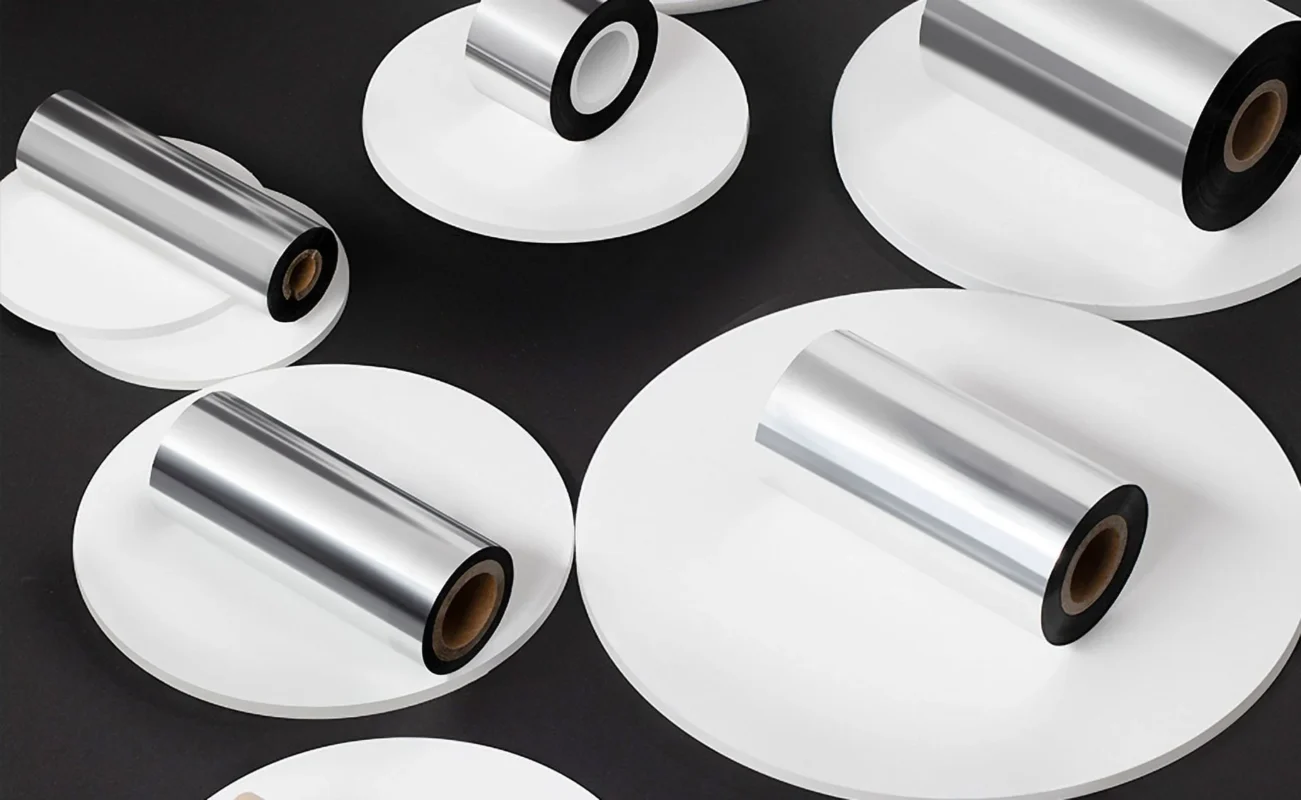Blog
Что такое лента для принтера штрих-кодов? Виды и способы применения
Thermal transfer printing depends on barcode ribbons to print long-lasting and high-quality barcodes and labels across logistics, retail, healthcare, and manufacturing sectors. Choosing the appropriate barcode ribbon leads to effective operations combined with distinct labeling and durable print outcomes. What Is a Barcode Printer Ribbon?
This guide covers everything about barcode ribbons including their definition and different types as well as their functionality with printers and label materials along with their various applications. Distributors along with purchasing managers and industrial buyers will find this article useful when they need to acquire the correct ribbons in large quantities.
What Is a Barcode Ribbon?
Definition
Barcode ribbons consist of coated film which enables ink transfer to label surfaces through thermal transfer printing that uses heat. Thermal transfer printing requires a ribbon to produce durable and precise prints in contrast to direct thermal printing that burns images onto special label coatings.
Composition
The typical barcode ribbon structure consists of three distinct layers.
- Backcoat: Protects the printhead
- PET Film Base: Provides stability
- The ink layer consists of either wax, wax-resin combination, or resin based on the required durability.
How Does Thermal Transfer Printing Work?
Thermal transfer printing operates by heating the printhead which melts the ink on the ribbon and transfers it to the label surface. Thermal transfer printing produces a durable print which stands up well against water, chemicals, UV light exposure and abrasive forces.
Thermal Transfer Components
- Printer: Flat-head or near-edge printers
- Ribbon: Wax, wax-resin, or resin
- Labels printed using thermal transfer printing techniques can be created on paper or synthetic substrates like polypropylene or polyester.
Types of Barcode Ribbons
1. Wax Ribbons
- Wax ribbons provide an economical solution with excellent print quality for paper labels.
- The durability rating is moderate because these prints can smear if they come into heavy contact or are exposed to heat.
- These products are ideal for printing shipping labels as well as retail tags and carton labels.
2. Wax-Resin Ribbons
- The wax-resin ribbon composition combines wax and resin elements to improve its durability.
- Durability: Smudge- and scratch-resistant
- The wax-resin ribbons are suitable for printing product ID labels and asset tags on semi-gloss/synthetic label materials.
3. Resin Ribbons
- Characteristics: Highest durability, chemical- and scratch-resistant
- Durability: Excellent; suitable for harsh environments
- Barcode labels for laboratories, components for automobiles, and tags for outdoor use
Barcode Ribbon Formats and Core Sizes
Widths
- Common widths: 40mm, 60mm, 83mm, 110mm, 160mm
- Should match or slightly exceed label width
Lengths
- Popular sizes: 74m, 300m, 450m, 600m, 900m
- Depends on printer type and label volume
Core Sizes
- 0.5-inch core: Desktop printers
- 1-inch core: Industrial printers
Matching Barcode Ribbons with Label Materials
Wax Ribbons Work Best With:
- Uncoated paper labels
- Semi-gloss labels (limited durability)
Wax-Resin Ribbons Work Best With:
- Coated paper
- Synthetic films like polypropylene
Resin Ribbons Work Best With:
- Polyester
- Polyimide
- Other high-durability synthetic materials
Importance of Matching Correctly
Choosing incorrect matches results in printhead damage, inferior print standards and unnecessary material loss. Always test compatibility before bulk production.
Industry Applications for Barcode Ribbons
Logistics and Warehousing
- Shipping labels
- Pallet tags
- Warehouse rack labeling
Retail and E-commerce
- Price tags
- Inventory barcodes
- Shelf labels
Healthcare and Pharmaceuticals
- Patient wristbands
- Lab sample labels
- Prescription packaging
Manufacturing and Automotive
- Part labels
- Instruction labels
- Quality control tags
Electronics and Chemicals
- Circuit board identification
- Hazardous material labels
Advantages of Using Thermal Transfer Barcode Ribbons
1. Superior Print Quality
Provides crisp text output together with distinct barcode images for extended reading lifespan.
2. Versatility
The product functions with numerous label varieties and multiple surface finishes.
3. Durability
The ribbon type determines its resistance to moisture, abrasive elements, heat exposure, and chemical interactions.
4. Longer Printhead Life
Using correctly matched ribbons minimizes equipment wear while increasing the equipment’s operational lifespan.

Buying Considerations for Bulk Barcode Ribbons
MOQ (Minimum Order Quantity)
The minimum order quantity for bulk barcode ribbons varies from 50 to 500 rolls based on the ribbon type, width specifications and the printing technique used.
Lead Time
Standard orders usually require 7–15 business days but custom widths or formulations extend lead times.
Customization Options
- Ribbon width and length
- Core size and orientation
- Packaging: boxed or shrink-wrapped
Sample Testing
Authorized suppliers provide complimentary or chargeable samples for testing compatibility.
How to Identify Barcode Ribbon Issues
Common Problems
- Faded prints
- Smudging
- Wrinkles in ribbon
- Breaks during printing
Troubleshooting Tips
- Adjust printhead pressure and temperature
- Check ribbon and label match
- Replace worn rollers or parts
Barcode Printer Ribbon vs Direct Thermal Printing
| Feature | Thermal Transfer (with ribbon) | Direct Thermal |
|---|---|---|
| Durability | High | Low |
| Supplies Needed | Ribbon + Label | Label only |
| Best For | Long-term, harsh conditions | Short-term, indoor |
| Common Use | Inventory, healthcare | Receipts, shipping labels |
Handling and Storage Tips
- Store flat or upright to prevent deforming
- Avoid dropping to prevent edge damage
Conclusion: Why Barcode Ribbons Matter in B2B Labeling
Barcode ribbons function as essential elements that enable precise and effective label systems across various industries. Choosing the proper ribbon type maintains label readability and durability throughout their storage journey, transit process and final application.
Industrial buyers together with purchasing managers and packaging suppliers must understand how wax, wax-resin, and resin barcode ribbons differ to improve print quality and operational expense management.
How do you select the most suitable barcode ribbon for your application needs? Our business provides customized solutions alongside dependable manufacturing services and worldwide delivery options.
👉 Contact us now
📧 sales@foyottr.com
📞 Tel: +86-592-6018318
🌐 https://foyottr.com/
Frequently Asked Questions (FAQ)
Q1: The main difference between wax ribbons and wax-resin ribbons is the latter’s added durability while resin ribbons provide superior performance for extreme conditions and synthetic labels.
A1: Wax ribbons are cost-effective for paper labels while wax-resin ribbons provide increased durability and resin ribbons are designed for extreme environments and synthetic labels.
Q2: Barcode ribbons require specific compatibility between the printer type and the label material.
A2: No. The ribbon type must correspond with both the printer design (flat-head or near-edge) and the type of label material used.
Q3: How long does a barcode ribbon last?
A3: Barcode ribbons remain usable for 1–2 years and deliver hundreds to thousands of prints depending on printer settings.
Q4: Which barcode ribbon width should I select for printing?
A4: The barcode ribbon needs to exceed the label width slightly to protect the printhead from damage.
Q5: Is your company able to provide OEM or private label barcode ribbon services?
A5: Yes. Our company accepts bulk and OEM orders that include custom specifications with packaging options for distributors and brands.
